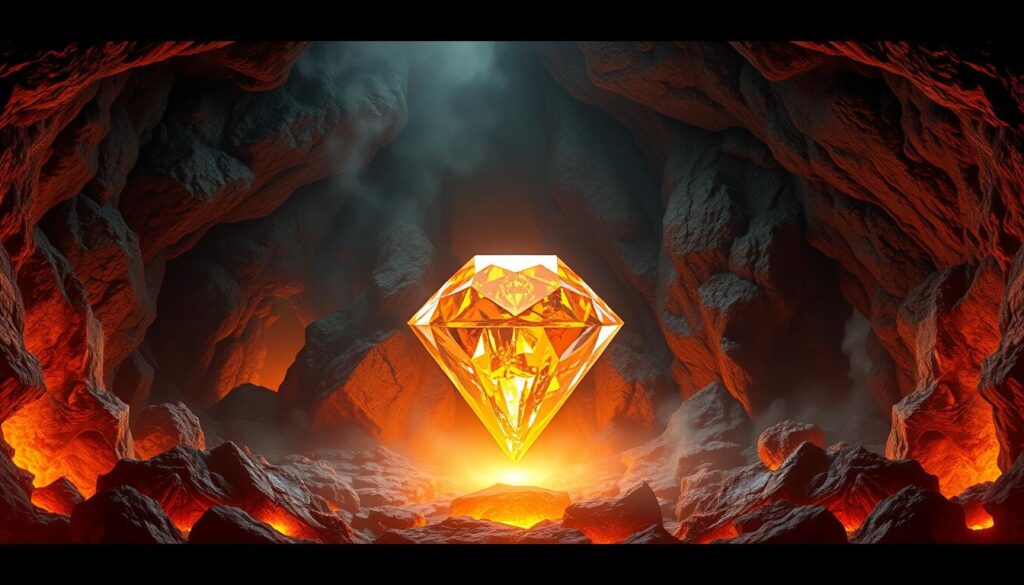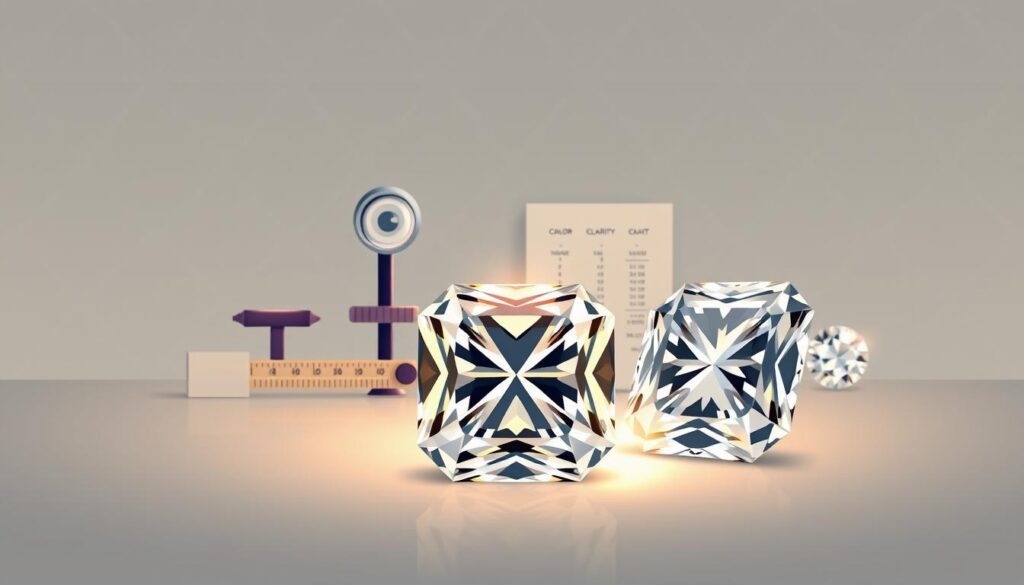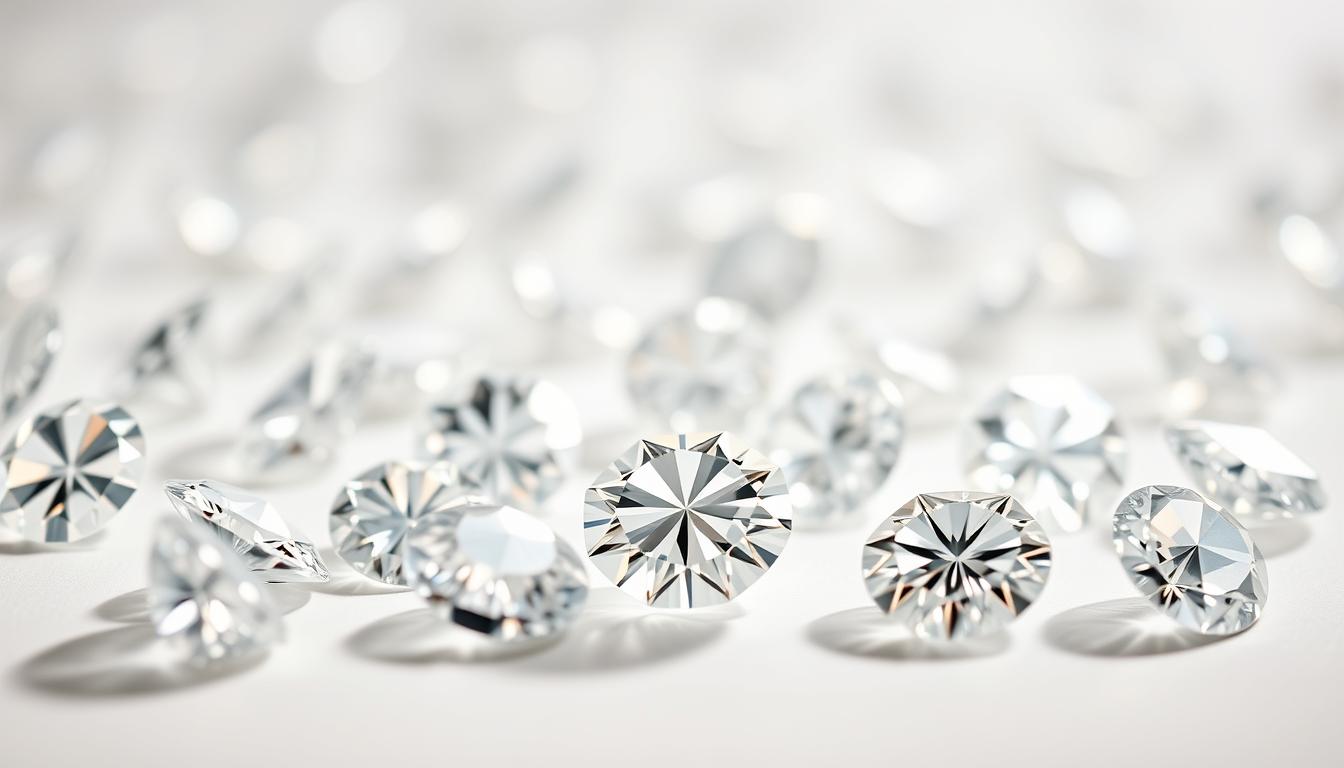Choosing a diamond should feel like discovering a piece of Earth’s magic – personal, meaningful, and free of uncertainty. Yet for many, the process becomes overwhelming. I remember helping my sister select her engagement stone: endless online searches, conflicting advice, and that nagging fear of overspending. It’s why expert guidance matters now more than ever.
Modern shoppers benefit from unmatched variety and transparency. Imagine browsing over 200,000 conflict-free gems from home, each with GIA certification and 360° HD views. Whether you prioritize speed, budget, or maximum sparkle, today’s options cater to every vision.
Quality isn’t just about the 4Cs – it’s about confidence. Virtual gemologists and concierge teams decode technical details so you focus on what matters: how the stone reflects light, fits your design dreams, or symbolizes your commitment. This human touch transforms specs on a screen into heirlooms with heart.
Value here means clarity, not compromise. Collections like Quick Ship or Best Value balance carat weight and cut precision without hidden markups. For those seeking rarity, exclusive reserves showcase stones where brilliance meets artistry. Every choice becomes a celebration, not a calculation.
Understanding the 4Cs of Diamonds
Navigating diamond selection starts with mastering its universal quality markers. The 4Cs – cut, color, clarity, and carat – form a science-backed framework created by the Gemological Institute of America (GIA). This system turns subjective beauty into measurable traits, helping you compare stones like a pro.
What the 4Cs Mean for Quality and Value
Cut reigns supreme among the 4Cs. A well-proportioned stone reflects light like a hall of mirrors, creating that signature sparkle. While color grades range from icy D to warm Z, most eye-clean gems fall between G-J – sweet spots where slight warmth goes unnoticed but saves budget.
Clarity tells the story of a stone’s journey underground. Tiny inclusions act like fingerprints, making each gem unique. Many flaws vanish to the naked eye in VS2-SI1 grades, offering smart savings. Carat weight? It’s not just size – a 1.5-carat gem costs 40% more than a 1-carat twin due to rarity.
How Cut, Color, Clarity, and Carat Impact Your Choice
Prioritize cut quality if brilliance matters most. A top-grade 0.9-carat stone often outshines a poorly cut 1.2-carat alternative. For color, consider your setting: yellow gold masks faint tints better than platinum. Balance clarity needs with reality – flawless gems dazzle under microscopes but rarely in real life.
Carat weight impacts both appearance and cost. Two half-carat stones in halo settings can mimic a larger centerpiece for less. Remember: GIA-certified grades protect your investment, letting you shop confidently knowing specs match reality.
The Journey of a Natural Diamond
Beneath our feet lies a story written in carbon and time. Over a billion years ago, carbon atoms 100 miles below the earth surface began their metamorphosis. Under crushing pressure and scorching heat – conditions found only in the deep earth – these atoms rearranged into nature’s most durable crystal structure. This alchemy transforms ordinary graphite into treasures that outlast civilizations.

From Rough Origins to Polished Brilliance
Mined from the deep earth, raw stones resemble cloudy pebbles more than jewels. Their true potential stays hidden until master cutters unlock it. Using diamond-tipped tools (the only material hard enough to shape them), artisans cleave and polish each stone for maximum brilliance. A single cut can take days – precision turns rough edges into facets that dance with light.
The crystal structure that makes these gems indestructible also makes them irreplaceable. Unlike synthetic alternatives, natural stones bear microscopic fingerprints – tiny inclusions formed during their billion-year journey. These quirks don’t diminish value; they authenticate a stone’s rare origin. When you hold a finished gem, you’re touching a fragment of Earth’s ancient heart.
Tips for Choosing Your Diamond
Finding the right gem involves equal parts heart and strategy. Let’s break down what really matters when selecting a stone that fits both your vision and lifestyle.
Assessing Budget and Expectations
Forget outdated rules about spending months of salary. Modern buyers focus on personal priorities – whether that’s maximizing sparkle, carat weight, or long-term value. A 0.9-carat stone with ideal proportions often outshines larger gems while saving 20-30%.
Consider near-colorless grades (G-H) and VS2 clarity: these offer eye-clean brilliance without premium pricing. Pro tip: Stones just below “magic sizes” like 1.00 carat cost less per milligram but look nearly identical when set.
Balancing Rarity with Personal Style
Round cuts dominate popularity charts, but pear or oval shapes can appear larger due to their weight distribution. Fancy cuts also let you prioritize carat size since they often cost less per carat than round brilliants.
Rarity doesn’t always mean better. Slight inclusions or warmer hues can add character while keeping budgets intact. Ask yourself: Does technical perfection matter more than how the gem makes you feel when it catches the light?
Key Factors that Affect Diamond Price
The numbers behind gem values reveal surprising market truths. Unlike everyday purchases, pricing follows natural scarcity rules – rarer stones command exponential cost jumps. A 2-carat gem often costs triple a 1-carat equivalent, not double, because larger sizes become dramatically harder to find.

Understanding Carat Weight, Rarity, and Inclusions
Magic sizes create sudden price leaps. Crossing 0.50 or 1.00 carat thresholds adds 15-20% cost – even if the stone barely looks bigger. Savvy shoppers often choose 0.97-carat gems over 1.00-carat ones for better per carat value.
Rarity isn’t just about weight. Colorless grades (D-F) cost 30% more than near-colorless (G-J) because truly white stones form less frequently. Inclusions affect prices too, but only visible flaws matter. Many VS2 clarity gems look identical to flawless ones under normal light.
Here’s the sweet spot: prioritize eye-clean clarity and near-colorless grades. Pair these with excellent cut quality, and you’ll get maximum sparkle without overpaying for invisible perfection. Remember – certification from labs like GIA ensures you’re paying for verified quality, not inflated claims.
Exploring Diamonds: Proven Gemology Insights
Behind every exceptional gem lies a story told through science and centuries of expertise. Modern gemology combines ancient wisdom with cutting-edge technology to reveal truths hidden within each stone.
The Role of Certification and Grading Labs
GIA and AGSL certifications act as your quality guardians. These labs use master stones and controlled lighting to assess clarity grades and color nuances. Their 11-grade clarity scale – from Flawless to Included – helps buyers understand what’s visible under magnification versus daily wear.
Why does this matter? A certified stone’s quality factors are verified objectively. You’ll know exactly how surface blemishes or internal inclusions affect value. This transparency prevents overpaying for imperfections only visible through specialized tools.
Historical & Scientific Perspectives on Diamond Formation
Grading systems trace back 2,000 years to India’s first methods evaluating color and carat weight. Today’s gemologists build on this rich history using microscopes and spectral analysis.
Science reveals these gems formed over a billion years ago under extreme mantle conditions. Inclusions and blemishes aren’t flaws – they’re nature’s autograph. Like tree rings, they document a stone’s journey through volcanic eruptions and continental shifts.
This dual lens – historical context and geological insight – transforms how we appreciate rarity. It’s not just about sparkle, but understanding the epic forces that created something enduring enough to become heirlooms.
Customizing Your Diamond Purchase Experience
Your gem deserves a selection process as unique as its sparkle. Modern buyers enjoy unprecedented control over their journey, from virtual inspections to tailored timelines. Imagine examining a stone’s fire and scintillation through HD 360° views – or requesting custom videos for gems not yet photographed. This isn’t just shopping; it’s curating a masterpiece.
Selecting Settings, Delivery Options, and More
Light performance transforms technical specs into visual magic. Polish grades (Excellent to Good) determine how smoothly surfaces reflect rays, while symmetry ensures facets align like precision mirrors. Depth percentages between 54-66% in round stones optimize sparkle, and table ratios influence how light dances across your gem.
Quick Ship options deliver stones in two days for time-sensitive celebrations. But there’s no rush to decide – concierge teams help decode fluorescence levels or compare carat weights in different settings. “A beautiful gem isn’t just graded; it’s experienced,” notes a virtual gemologist. “We translate numbers into real-world brilliance.”
Every stone shines differently under varied lighting. Book a consultation to see how proportions interact with your preferred style. With expert guidance, you’ll balance technical excellence with emotional resonance – crafting a treasure that feels unmistakably yours.
Conclusion
Selecting your perfect gem combines science with personal storytelling. The cut quality remains your sparkle blueprint – masterful proportions turn light into fireworks. While colorless diamonds dazzle, G-J grades offer icy brilliance at friendlier prices when paired with platinum or white gold settings.
Clarity grades and carat weight tell two truths: eye-clean stones hide microscopic blemishes, and strategic sizes (like 0.9 carats) maximize visual impact. Remember, certification isn’t just paperwork – it’s your proof that quality factors like symmetry and polish meet expert standards.
Your journey balances rarity with reality. Near-colorless options and VS2 clarity gems prove beauty doesn’t require perfection. With virtual tools and gemologist insights, you’re not just buying a stone – you’re curating a legacy that reflects both Earth’s artistry and your unique vision.
